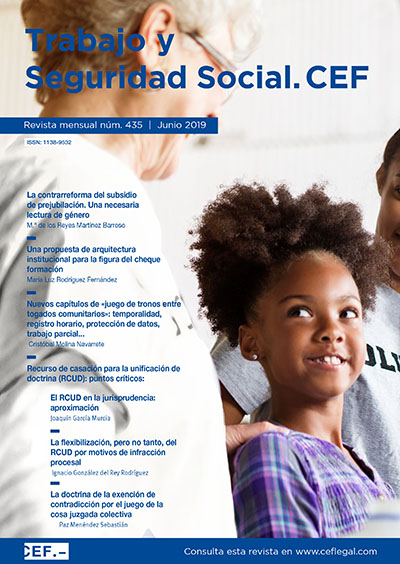Empirical study on the influence of demographic and functional diversity in human resources
DOI:
https://doi.org/10.51302/rtss.2019.1302Keywords:
diversity, organizational demography, workgroup compositionAbstract
The influence of workgroup diversity has aroused a growing interest in empirical literature on the field of human resources. However, previous research shows inconclusive findings, both positive and negative effects, and even some works do not evidence any impact. Extending previous studies, we analyse the influence of diversity at an organisational level. For that purpose, we first review some of the most accepted rationales regarding to the linkage between diverse composition in organizational groups and performance. We emphasize on some leading and specific approaches such as the organizational demography perspective and the relational demography research, additionally to the viewpoint of the information processing and decision making perspective. Using statistical methods, we present an empirical study in order to test whether both functional and gender diversity of human resources affects performance and financial success objectives. We use a sample of Spanish firms during the 2008-2016 years, which is particularly interesting due to the crisis affecting the business world along such period. The results of our study indicate that diversity has a significant positive influence both on company outcomes and on sales volume.
Downloads
References
Abreu, C. R. de, Sastre, M. A. y Roig, S. (2007). Diversity and business performance: 50 years of research. Service Business, 1(4), 257-274.
Brooke, J. y Tyler, T. R. (2011). Diversity and corporate performance: A review of the psychological literature. North Carolina Law Review, 89, 715-748.
Brubaker, R. y Cooper, F. (2000). Beyond «identity». Theory and Society, 29, 1-47.
Choi, J. N., Sung, S. Y. y Zhang, Z. (2017). Workforce diversity in manufacturing companies and organizational performance: the role of status-relatedness and internal processes. The International Journal of Human Resource Management, 28(19), 2738-2761.
Cox, T. H. y Blake, S. (1991). Managing cultural diversity: Implications for organizational competitiveness, The Executive, 5(3), 45-56.
Dahlin, K. B., Weingart, L. R. y Hinds, P. J. (2005). Team diversity and information use. Academy of Management Journal, 48(6), 1107-1123.
Daily, C. M. y Dalton, D. R. (2003). Women in the boardroom: A business imperative. The Journal of Business Strategy, 24(5), 8-9.
Dass, P. y Parker, B. (1999). Strategies for managing human resource diversity: From resistance to learning. Academy of Management Executives, 13(2), 68-80.
Davis, J. B. (2007). Akerlof and Kranton on identity in economics: Inverting the analysis. Cambridge Journal of Economics, 31, 349-362.
Goette, L., Huffman, D. y Meier, S. (2012). The impact of social ties on group interactions: Evidence from minimal groups and randomly assigned real groups. American Economic Journal: Microeconomics, 4(1), 101-115.
Harrison, D. A. y Klein, K. J. (2007). What's the difference? Diversity constructs as separation, variety, or disparity in organizations. Academy of Management Review, 32(4), 1199-1228.
Jackson, S. E., Joshi, A. y Erhardt, N. L. (2003). Recent research on team and organizational diversity: SWOT analysis and implications. Journal of Management, 29(6), 801-830.
Jehn, K. A. y Bezrukova, K. (2004). A field study of group diversity, workgroup context and performance. Journal of Organizational Behavior, 25(6), 703-729.
Jehn, K. A., Northcraft, G. B. y Neale, M. A. (1999). Why differences make a difference: A field study of diversity, conflict, and performance in workgroups. Administrative Science Quarterly, 44(4), 741-763.
Milliken, F. J. y Martins, I. L. (1996). Searching for common threads: Understanding the multiple effects of diversity in organizational groups. Academy of Management Journal, 21(2), 402-433.
Omanović, V. (2011). Diversity in organizations: A critical examination of assumptions about diversity and organizations in twenty-first century management literature. En E. L. Jeanes, D. Knights y Y. M. Martin (Eds.), Hand-book of gender, work & organization (pp. 315-332). West Sussex: John Wiley & Sons.
Pelled, L. H., Eisenhardt, K. M. y Xin, K. R. (1999). Exploring the black box: An analysis of work group diversity, conflict, and performance. Administrative Science Quarterly, 44, 1-28.
Pfeffer, J. (1983). Organizational demography. Research in Organizational Behavior, 5, 299-357.
Ragins, B. R. y González, J. A. (2003). Understanding diversity in organizations: Getting a grip on a slippery construct. En J. Greenberg (Ed.), Organizational behavior. The state of the science (pp. 121-158). London: Lawrence Erlbaum Associates, Publishers.
Richard, O. C. (2000). Racial diversity, business strategy and firm performance: A resource-based view. Academy of Management Journal, 43(2), 164-177.
Roberson, Q., Ryan, A. M. y Ragins, B. R. (2017). The evolution and future of diversity at work. Journal of Applied Psychology, 102(3), 483-499.
Robinson, G. y Dechant, K. (1997). Building a business case for diversity. Academy of Management Executive, 11(3), 21-30.
Tsui, A. S., Egan, T. D. y O'Reilly III, C. A. (1992). Being different: Relational demography and organizational attachment. Administrative Science Quarterly, 37(4), 549-579.
Van Knippenberg, D., Dreu, C. K. W. de y Homan, A. C. (2004). Work group diversity and group performance: An integrative model and research agenda. Journal of Applied Psychology, 89(6), 1008-1022.
Westphal, J. D. y Milton, L. P. (2000). How experience and network ties affect the influence of demographic minorities on corporate boards. Administrative Science Quarterly, 45, 366-417.
Williams, K. Y. y O’Reilly, C. A. (1998). Demography and diversity in organizations: A review of 40 years of research. Research in Organizational Behavior, 20, 77-140.


















